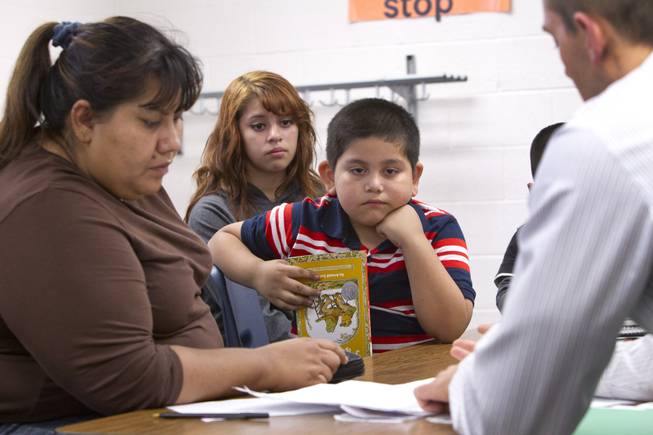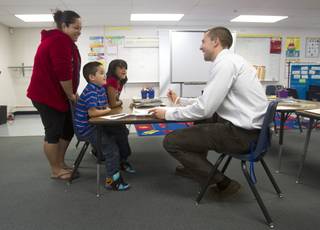
Melynda Espinoza (background),15, interprets for her mother Irene during a parent-teacher conference for her brother Miguel, center, at Lois Craig Elementary School in North Las Vegas Wednesday, Oct. 23, 2013. About 80 percent of students at the school are Hispanic.
Wednesday, Oct. 30, 2013 | 2 a.m.
Craig Elementary School
Charlie Lockwood pulls a sheet of paper from a green folder and sets it on the table in front of Fabiola Rosales.
It’s a writing sample from Rosales’ 6-year-old son, Angel. The Craig Elementary School first-grader began his short essay by scrawling, “My family is nice.”
“This is a lot better than most,” Lockwood says, scanning Angel’s paper. “He’s getting his ideas down. He’s spelling most of his words correctly. The only thing is his printing.”
Angel’s teacher slides the essay toward Rosales, pointing out some messy penmanship, missed capitalization and periods, as well as some large spacing between words. Angel looks on as he sits next to his mother in Lockwood’s classroom, which is filled with colorful posters and books.
“Remember, Mr. Lockwood’s eyes are old,” the 24-year-old first-year teacher says, smiling as he addresses Angel. “Angel, you can print a little nicer. You need to work on your ‘finger-spaces.’”
Rosales, wearing a red sweater and flip-flops, nods as she listens to her 9-year-old daughter, Marisola, translate Lockwood’s words from English to Spanish.
“Any questions?” Lockwood asks Rosales, as Marisola, a fourth-grader, finishes translating.
Rosales shakes her head and utters a quiet, “No.” Lockwood moves on to share Angel’s grades in math.
Last week, thousands of parents streamed into Clark County’s 217 elementary schools for this year's first round of parent-teacher conferences. District officials say these twice-a-year conferences serve an important purpose: to inform parents of their children’s progress in the classroom.
Informed and engaged parents can help their children make course corrections, steering them toward good study habits and grades. But how informed and engaged can parents be when there is a significant language barrier between teachers and parents?
There are nearly 150 languages spoken in the homes of Clark County students, according to district officials. The majority of non-English-speaking students’ families speak Spanish, with Tagalog — a language from the Philippines — a distant second. Languages from across the world — Africa, Asia, Europe and South America — are represented among parents and students in the School District.
Although the district provides some translation services and several nonprofits work with non-English-speaking parents on engagement, there’s not enough translators come parent-teacher conference time.
Of the 19 students in Lockwood’s class, only three students’ parents speak English. Most non-English-speaking parents showed up with a relative or friend to help translate what Lockwood was telling them about their child’s academic status.
Many of these unofficial translators were siblings like Marisola, who tend to give shorter and watered-down translations. This leaves teachers like Lockwood wondering exactly how much of what they are telling parents is getting lost.
“I’m pleasantly surprised how parents genuinely care and want to help their kids,” Lockwood said. “There’s a misconception that these kids don’t have support at home. That perception isn’t right. These parents do care.”
• • •
The number of students who don't speak English has doubled in the past decade as thousands of immigrants flocked to Las Vegas, seeking employment opportunities.
They settled in Southern Nevada and became an integral part of hospitality and gaming on the Las Vegas Strip. They had children — 90 percent of them American citizens — who enrolled in local schools.
Consequently, nearly a fifth of the Clark County School District’s 315,000 students — more than 60,000 — are English-language learners. These students have among the lowest test scores and graduation rates in CCSD, the nation’s fifth-largest school system.
It’s a common misconception that English-language learners are found solely in urban, inner-city schools. Nearly all 357 CCSD schools have at least one ELL student.
At Craig Elementary, about 60 percent of its 770 students are English-language learners. The northern Las Vegas Valley school is one of 14 Clark County schools sharing more than $39 million in additional state funding over the next biennium to help ELL students catch up to their English-speaking peers.
These “Zoom to Literacy” schools have longer school years and smaller class sizes, and provide tuition-free pre-kindergarten and full-day kindergarten classes. “Zoom” schools also feature special reading centers that give students an additional half-hour of reading time above the 110 minutes mandated by the state.
Craig has embraced the mission, Lockwood said. At every parent-teacher conference, Lockwood asks his students and parents if they are reading at home, and he offers to lend out letter cards and books from his classroom.
Lockwood knows the research on English-language learner students: If they can’t read by third grade, they’re less likely to graduate.
• • •
Lockwood is no stranger to language barriers. The newly minted teacher was born in the Central African country of Burundi, the son of parents who were former Peace Corps members.
Until he was 6 years old, Lockwood attended the Lusaka International School, where he sat in class with children from Afghanistan and Ethiopia, Netherlands and Germany, England and America.
Just before he turned 7, Lockwood’s family moved to Fallon, a town of 40,000 people about 60 miles east of Reno. His father became a manager at a local golf course; his mother worked her way up through the Churchill County government, ultimately becoming county manager.
Lockwood credits his parents with instilling in him the value of education and public service. Following in a grandparent’s teaching profession, Lockwood studied education at UNR, and after graduation, moved to Las Vegas to teach at Craig.
From the moment he stepped foot into his classroom at Craig, Lockwood was acutely aware of the difference between his students’ upbringing and his own.
One of Lockwood’s first assignments asked his students to write about their most memorable experience over the summer. While Lockwood’s 6-year-old self would have written about his overseas travels, his 6- and 7-year-old students wrote about trips to Circus Circus and Chuck E. Cheese’s.
“How I was raised is totally different (from my students),” Lockwood said. “It was humbling for me.”
Despite these differences, Lockwood understands his mission: to get students caught up and ready for second grade. Over the first two months of the school year, Lockwood has been busy teaching and assessing students’ abilities in a wide range of subjects.
One key assessment tests students on how many words they can read from a passage in one minute. At the start of first grade, half of Lockwood’s students should be able to read 13 words. Most can read only about six words. Two students couldn’t read a single word. By the end of the school year, the goal is to be able to read 300 words.
It’s a tall order for Lockwood, who started his first year of teaching this fall. Having engaged parents reading to children would help his students catch up in reading, he said.
“Parent engagement is huge, especially for the kids who are struggling,” Lockwood said. “But if you can’t speak English, how can you help?”
• • •
Back in classroom 26, Lockwood is greeting Irene Garcia, the mother of 6-year-old first-grader Miguel Espinoza.
“Miguel is an excellent kid — very well behaved,” Lockwood tells Garcia, pausing to wait for her 15-year-old daughter, Melynda Espinoza, to finish translating.
Lockwood shares Miguel’s reading test with Garcia. Unlike many of his peers, Miguel was able to read 54 words in a minute. Lockwood’s goal for Miguel is for him to read 100 words in a minute by December.
“Miguel is an excellent reader, the best in the class,” Lockwood says, looking at Garcia and Melynda, a Canyon Springs High School sophomore. “He’s above and beyond in reading. But he’s got to stay up there.”
Lockwood pauses again and waits for Melynda to finish translating. Garcia replies in Spanish, which Melynda translates into English for Lockwood.
“My mom asked whether Miguel dropped down a reading level,” Melinda asks in her mother’s stead. “He doesn’t like reading any more because he’s on the iPad all the time. He says he’s doing the work though.”
“I would just take the iPad away,” Lockwood tells Garcia. “Miguel is going to need to keep reading. Second grade is going to be challenging. We want to keep challenging him.”
Miguel is ready for chapter books, Lockwood says, handing Garcia a book she can’t read herself. Picture books are too easy for Miguel, Lockwood adds.
One task for Miguel will be sounding out his letters and words, Lockwood says. The new, more rigorous Common Core academic standards will require students to solve story problems in math and science. Reading will be integral in all subjects, not just English.
Many English-language learner students are learning English with their parents, Lockwood said later. Older siblings, some who have mastered the language, often end up helping parents and siblings learn English.
“Do you have your sister quiz you, or do you study by yourself?” Lockwood asks Miguel, sitting between Garcia and Melynda.
Miguel mumbles that he reads and studies mostly by himself.


Join the Discussion:
Check this out for a full explanation of our conversion to the LiveFyre commenting system and instructions on how to sign up for an account.
Full comments policy